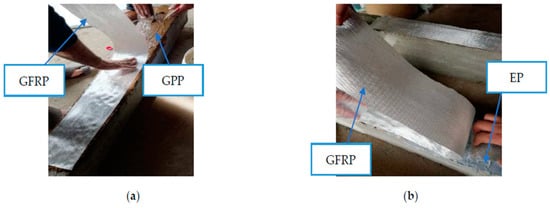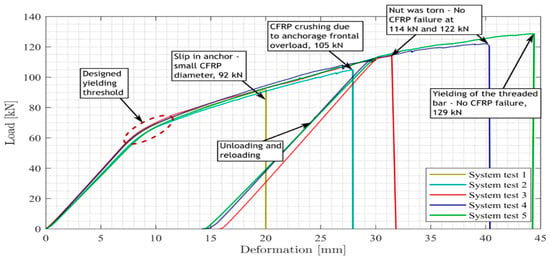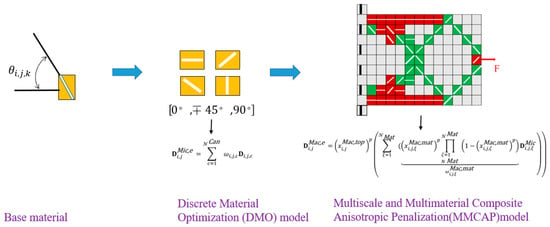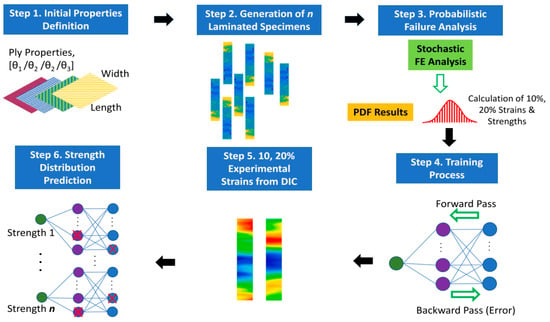Advanced composite materials have excellent performance and broad engineering application prospects, and have received widespread attention in recent years. Advanced composite materials can mainly be divided into fiber-reinforced composite materials, laminated composite materials, matrix composite materials, and other composite materials.
- advanced composite materials
- structure strengthening
- resilience improvement
- fiber-reinforced composite materials
- laminated composite materials
- matrix composite materials
1. Introduction
2. Fiber-Reinforced Composite Materials in Structural Reinforcement and Resilience Enhancement
2.1. Comparison of Common Fiber-Reinforced Composite Materials and Their Mixing Techniques
One of the biggest problems facing contemporary civil engineering is the strengthening, updating, and transformation of old structures. One of the most promising answers to these needs is the use of fiber-reinforced polymer (FRP). FRP is a composite material composed of synthetic fibers (such as carbon, glass, asbestos, beryllium, molybdenum, and aromatic polyamides) and synthetic polymer matrices (such as epoxy resin, polyester, and vinyl ester) [1]. Glass fiber-reinforced polymer (GFRP) and carbon fiber-reinforced polymer (CFRP) are the most suitable reinforcement materials for various civil engineering applications, as they have the highest temperature resistance, greatest strength, and lowest cost [2]. Bonding carbon fiber-reinforced polymer (CFRP) to the tensile surface of components can significantly improve structural strength. In addition, the type of adhesive material used is important to prevent debonding of the CFRP. Rageh has proposed two unique methods to enhance the adhesion between glass fiber-reinforced polymer (GFRP) and RC concrete surfaces, as shown in Figure 1 [3]. The purpose of Figure 1 is to demonstrate how CFRP is bonded to RC concrete beams through two different bonding materials, EP and GPP. The two adhesive materials are epoxy (EP) and geopolymer (GPP) with different proportions of short glass fiber (SGF). A more conventional method than the two proposed unique methods is to use epoxy resin to bond structural elements to steel plates. Through experiments and ABAQUS simulations, it has been proven that geopolymer slurries with and without short glass fibers in reinforced beams outperform epoxy resins in terms of performance and cost. At the same time, increasing the SGF ratio in GPP has a significant effect on improving the bearing capacity of the beam. GPP as an adhesive material enhances the maximum beam deflection and the beam ductility factor better than EP.



2.2. Methods for Improving the Performance of Fiber-Reinforced Composite Materials

2.3. Model Algorithm for Optimizing Fiber-Reinforced Composite Materials
Establishing model optimization algorithms plays an important role in the development of fiber-reinforced composite materials. At present, the commonly used modeling methods include multiscale topology optimization, theoretical model, and so on. Optimization algorithms mainly include genetic algorithms, trial-and-error methods, etc. The application of these models and algorithms can better predict the mechanical properties of composite materials, thereby optimizing the ratio and preparation process of composite materials. Alhaddad uses artificial neural network modeling methods to predict the performance of composite materials, especially the ultimate tensile strength [22][16]. At the same time, the artificial bee colony algorithm is used to optimize printing and material parameters to achieve maximum tensile strength. The research results indicate that fiber properties, fiber morphology, fiber orientation, and fiber volume fraction have the greatest impact on the tensile strength of composite materials. Duan introduced a novel multiscale and multimaterial anisotropic penalty (MMCAP) model [23][17]. This model is tailored for exploring the design optimization of composite structures with variable stiffness (VS), reinforced with fibers. The objective is to minimize structural compliance, as demonstrated in Figure 5. This model utilizes improved solid isotropic material punishment (SIMP) and discrete material optimization (DMO) at the macro- and microscales, respectively, to achieve clear macromultimaterial structure topology and microspecific discrete fiber-laying angle selection. This method can effectively achieve multimaterial and multiscale design optimization of fiber-reinforced composite structures, achieving clear macroscopic topology of multimaterial structures and microscopic fiber-laying angles. This provides a new implementation strategy for lightweight, multimaterial, and multiscale design optimization of composite materials. Obid has proposed a new constitutive model that can describe the tensile and compressive responses of nonlinear anisotropic fiber materials under general stress states [24][18]. Built upon the Ramberg–Osgood model, this framework is expanded by incorporating triaxial stress invariance as a marker for stress-state classification. This extension aims to account for tension–compression asymmetry within multiaxial stress conditions. Compared to other models, this model provides an elegant formula for describing all phenomena and implements a simple calibration program. Therefore, this method can describe the nonlinear behavior and tension compression asymmetry of fiber-reinforced composite materials, and has better advantages.
2.4. Application of Fiber-Reinforced Composite Materials in Practical Projects
3. Laminated Composite Materials in Structural Reinforcement and Resilience Enhancement
3.1. Effect of Changing the Deposition Order on the Properties of Laminated Composite Materials
Laminated composite materials are composite materials composed of two or more layers of different materials combined in a specific way, with good mechanical properties and various application fields. In order to further improve the strength and resilience of laminated composite materials, various new methods have been proposed, for example, changing the deposition sequence, adding synthetic fibers, interlayer reinforcement technology, design optimization, explosion-proof welding methods, etc. The deposition sequence and deposition materials are important factors affecting laminated composite materials. In recent years, many researchers have conducted experiments on material manufacturing and deposition sequence. Bhaburi et al. estimated the surface/interface quality, microstructure, and mechanical properties of hybrid aluminum parts, and improved their microhardness and joint strength through heat treatment [37][22]. In the field of laminated composite materials, SS316L and Inconel 718 alloy laminated composite materials are manufactured through mixed additives and subtraction to obtain materials with good mechanical and high-temperature properties.3.2. Methods for Improving the Performance of Laminated Composite Materials
In addition to the main method of changing the sedimentary sequence, many other new methods have been proposed in recent years. Kumar studied the preparation process for titanium alloy laminates for multilayer composite material input [39][23]. Thise study used a single stage process instead of rolling to prepare laminated plates, and investigated the sliding wear behavior of Ti-6Al-4V laminated plates. The research results indicate that composite materials have better wear resistance and lower wear rate than matrix materials, and the hardness value of composite materials is increased by about 25% compared to matrix materials. Biswas used the finite element method to study the effect of fiber orientation on the tensile, bending, and fatigue properties of bidirectional glass and carbon fiber-reinforced composite laminates [40][24]. The experimental results show that laminates with a laminate angle of (0°/90°) exhibit the maximum tensile strength, bending strength, and fatigue life. The tensile strength, bending strength, and fatigue life decrease with the increase in layer angle, and the layer angle reaches the minimum value (±45°). Therefore, the fiber orientation of composite materials can affect the quality of laminated materials.3.3. Modeling and Simulation for Optimization of Laminated Composite Materials
At present, models and software simulations have been widely established and applied toward laminated composite materials. Among them, finite element analysis and the genetic algorithm are the most commonly used methods, which can simulate the mechanical behavior of composite materials. In addition, multiscale simulation methods based on microstructure are gradually receiving attention, which can more realistically reflect the microstructure and mechanical properties of composite materials. Coelho described a computational model for designing bimaterial composite laminates using a multiscale topology optimization model to optimize the design of structures and materials [48][25]. The model is based on a hierarchical optimization strategy, taking into account the manufacturing process and basic characteristics, and using a mixed set of micro- and macrodesign variables to characterize the distribution of the two materials. This method has yielded better design results, which helps to provide a deeper understanding of the effectiveness of the microstructure characteristics of composite laminates. Shi employed the LS-DYNA software to simulate the dynamic and progressive failure process in laminated composite materials [49][26]. This simulation utilized the MAT_162 material models, encompassing factors such as strain rate, damage evolution, and anisotropy effects. To determine the model parameters, traditional standard and nonstandard testing methods were used, including double shear and Brazilian testing. Through experiments and numerical simulation, the fidelity of the developed material model parameters was verified, including the modulus and strength in plane and full thickness directions, fiber matrix splitting and shear fracture, and other failure modes. Nastos introduced a strength prediction method for composite laminates based on a combination of numerical and nondestructive testing, aiming to predict strength through nondestructive testing, as shown in Figure 106 [50][27].
3.4. Application of Laminated Composite Materials in Practical Engineering Projects
4. Matrix Composite Materials in Structural Reinforcement and Resilience Enhancement
4.1. Methods for Improving the Properties of Metal Matrix Composite
The strength and resilience improvement in metal matrix composite is one of the current research hotspots. Its new methods mainly focus on the stirring–casting method, material microstructure design, processing technology optimization, surface modification, and addition of appropriate second equalities. Rajaram studied the effect of particle weight fraction on the mechanical properties of metal matrix composite (MMC) by stirring–casting [66][33]. Metal matrix was prepared using aluminum (Al7075) and quarry rock dust powder, with 0%, 5%, and 7.5% rock powder and Al7075 added. Hardness, bending, and wear tests were conducted, and machining was carried out according to ASTM standards. Thise research found that the quarry stone powder of Al7075 has a higher hardness and lower wear rate, and the metal matrix containing 7.5 wt.% has the highest bending degree. Therefore, sample 2 has higher hardness and wear resistance.4.2. Methods for Improving the Properties of Ceramic Matrix Composite
The strength and resilience improvement in ceramic matrix composite is one of the research focuses in the field of composites. Among them, using new methods to enhance strength and resilience is one of the main directions of current research, and common methods include nanoparticle reinforcement, adding new elements, microstructure regulation, and powder metallurgy, among others. Li found that the Nb content and sintering temperature significantly affect the phase formation and microstructure of the sample, while the width of the Ti2 AlC layered structure increases with the increase in sintering temperature [80][34]. The optimal compressive strength of Ti2AlC MAX phase ceramic matrix composites was obtained under optimized Nb content (1 wt.%) and sintering temperature (1300 °C). Thise work demonstrates that LPBF and sintering methods can be used to design composite materials, and explores the properties of Ti2AlC MAX phase ceramics from the perspective of microalloying. Xi investigated the effect of mixed ceramic reinforcement content on the mechanical properties of aluminum matrix composites [81][35]. They used laser powder bed fusion to prepare composites reinforced with different contents of (ZrC TiC) ceramic fractions. The results showed that with the increase in mixed ceramic content, the laser absorption behavior of the composite material is enhanced, and the fraction of nanoparticles increases. The composites containing 20 wt.% ceramics exhibited high micro- and nanohardness, and the elastic modulus and tensile strength of 15 wt.% (ZrC + TiC)/Al composite material were significantly higher than the unreinforced Al matrix, due to the formation of nanoprecipitates and coherent binding at the reinforcement/matrix interface.4.3. Application of Matrix Composite Materials in Practical Engineering Projects
Matrix composite materials have a wide range of applications due to their special properties, and have been applied in recent years in biomedical, biodegradable, brake pads, radiation shielding, and other related fields. Manso studied how to improve the wear resistance of metal bone implants by adding hard reinforcements [91][36]. Studying the use of nontoxic and nonallergenic β, two different in situ composite materials were prepared by adding NbC powder to Ti-Nb alloy as the matrix material. This strategy can achieve the synthesis of reinforcing phases during the manufacturing process and achieve strong interface bonding through high chemical compatibility. The results showed that the friction and corrosion properties of both composite materials were improved, and the wear amount was less than 50%. These results indicate that the matrix composite material is a potential bone implant material that can improve its wear resistance and degradation process. Kabir’s study introduced a zinc-based composite material for biodegradable implant materials, which added graphene nanosheets to improve its mechanical properties and corrosion behavior [92][37]. The research results show that the composite material has high mechanical properties and good biocompatibility, making it a potential biodegradable implant material. In the past few years, carbon ceramic brakes have been favored for their light weight, high-temperature resistance, and long lifespan.5. Other Composite Materials in Structural Reinforcement and Resilience Enhancement
5.1. Theoretical Research and Practical Application of Viscoelastic Materials
Viscoelastic materials have characteristics such as elastic behavior, noninstantaneous deformation, and viscosity, making them the main materials for manufacturing viscoelastic dampers. Xu developed viscoelastic materials based on different matrix rubbers and conducted experiments [96][38]. The results indicate that the viscoelastic damper based on a nitrile rubber matrix has high energy dissipation capacity, while the viscoelastic damper based on a silicone rubber matrix has stable performance under different working conditions. To elucidate its mechanical properties, an equivalent high-order fractional derivative model considering temperature and frequency effects was proposed, and numerical results consistent with experimental results were obtained. Xu introduced the application of viscoelastic dampers in seismic reduction [97][39]. Firstly, the mathematical model of VE dampers and the dynamic analysis of structures with VE dampers were introduced. Then, an equivalent standard solid model is used to describe the effect of temperature on the energy absorption characteristics of VE dampers. Finally, the response of a three-story reinforced-concrete frame structure with and without VE dampers was studied through elastic–plastic time field analysis, frequency field analysis, and shaking table tests. The results showed that VE dampers can be modeled using an equivalent standard solid model, and are effective in reducing structural seismic response. Xu introduced the preparation and performance testing of acrylic viscoelastic dampers [98][40].5.2. Theoretical Research and Practical Application of Magnetorheological Materials
Magnetorheological fluid has the characteristics of adjustability, fast response speed, small size, and light weight, making it the main material for manufacturing magnetorheological dampers. Xu conducted research on magnetorheological fluids and their composite materials [101][41]. Magnetorheological fluid is an intelligent material widely used for structural vibration reduction, consisting of iron particles, carrier fluid, and additives. One of the research hotspots is the expectation that ferromagnetic particles have low density and high magnetic properties. Thise article uses ultrasonic and mechanical stirring–grafting techniques to coat multiwalled carbon nanotubes (MWNT) onto carbonyl iron (CI) particles; an electron microscope image is shown in Figure 17. In addition, shear yield stress tests were conducted on self-made composite materials, and the test results were compared with the theoretical values of the single- and double-chain micromechanical model to verify the effectiveness and accuracy of the proposed model. Xu discussed how to control the vibration response in aerospace or precision instrument platforms in the frequency range of 0 to 500 Hz [102][42].
5.3. Performance Improvement and Practical Application of Concrete Mortar Composite Materials
5.3. Performance Improvement and Practical Application of Concrete Mortar Composite Materials
6. Conclusions
References
- Codispoti, R.; Oliveira, D.V.; Olivito, R.S.; Lourenço, P.B.; Fangueiro, R. Mechanical performance of natural fiber-reinforced composites for the strengthening of masonry. Compos. Part B 2015, 77, 74–83.
- Aravind, N.; Samanta, A.K.; Thanikal, J.V.; Roy, D.K.S. An experimental study on the effectiveness of externally bonded corrugated GFRP laminates for flexural cracks of RC beams. Constr. Build. Mater. 2017, 136, 348–360.
- Rageh, B.O.; El-Mandouh, M.A.; Elmasry, A.H.; Attia, M.M. Flexural Behavior of RC Beams Strengthened with GFRP Laminate and Retrofitting with Novelty of Adhesive Material. Buildings 2022, 12, 1444.
- Radfar, S.; Foret, G.; Saeedi, N.; Sab, K. Simulation of concrete cover separation failure in FRP plated RC beams. Constr. Build. Mater. 2012, 37, 791–800.
- De Maio, U.; Fabbrocino, F.; Greco, F.; Leonetti, L.; Lonetti, P. A study of concrete cover separation failure in FRP-plated RC beams via an inter-element fracture approach. Compos. Struct. 2019, 212, 625–636.
- Fu, B.; Teng, J.G.; Chen, J.F.; Chen, G.M.; Guo, Y.C. Concrete Cover Separation in FRP-Plated RC Beams: Mitigation Using FRP U-Jackets. J. Compos. Constr. 2017, 21, 04016077.
- Yazdani, N.; Aljaafreh, T.; Beneberu, E. Concrete beam flexural strengthening with anchored pre-saturated CFRP laminates. Compos. Struct. 2020, 235, 111733.
- Grelle, S.V.; Sneed, L.H. Review of Anchorage Systems for Externally Bonded FRP Laminates. Int. J. Concr. Struct. Mater. 2013, 7, 17–33.
- Schmidt, J.W.; Sørensen, J.D.; Christensen, C.O. In Situ Concrete Bridge Strengthening Using Ductile Activated NSMR CFRP System. Buildings 2022, 12, 2244.
- Alam, P.; Mamalis, D.; Robert, C.; Floreani, C.; Brádaigh, C. The fatigue of carbon fibre reinforced plastics—A review. Compos. Part B 2019, 166, 555–579.
- Yang, Z.; Yang, Z.; Chen, H.; Yan, W. 3D printing of short fiber reinforced composites via material extrusion: Fiber breakage. Addit. Manuf. 2022, 58, 103067.
- Song, H.; Liu, T.; Gauvin, F.; Brouwers, H.J.H. Improving the interface compatibility and mechanical performances of the cementitious composites by low-cost alkyl ketene dimer modified fibers. Constr. Build. Mater. 2023, 132186, 395.
- Lee, S.; Hong, C.; Ji, W. In situ micromechanical analysis of discontinuous fiber-reinforced composite material based on DVC strain and fiber orientation fields. Compos. Part B 2022, 247, 110361.
- Batu, T.; Lemu, H.G. Investigation of mechanical properties of false banana/glass fiber reinforced hybrid composite materials. Results Mater. 2020, 6, 100131.
- Zhang, X.; Li, K.Z.; Li, H.J.; Fu, Y.W.; Fei, J. Tribological and mechanical properties of glass fiber reinforced paper-based composite friction material. Tribol. Int. 2014, 69, 156–167.
- Wa, A.; Envelope, M.; Yh, B.; Kyma, A. Optimizing the material and printing parameters of the additively manufactured fiber-reinforced polymer composites using an artificial neural network model and artificial bee colony algorithm. Structures 2022, 46, 1781–1795.
- Duan, Z.; Liu, Y.; Fan, J.; Long, K.; Xu, B.; Zhu, J.; Yan, J. Concurrent multi-material and multi-scale design optimization of fiber-reinforced composite material and structures for minimum structural compliance. Compos. Struct. 2023, 311, 116796.
- Obid, Š.; Halilovič, M.; Urevc, J.; Starman, B. Non-linear elastic tension-compression asymmetric anisotropic model for fibre-reinforced composite materials. Int. J. Eng. Sci. 2023, 185, 103829.
- Lv, Z.Z.; Wang, J.; Guo, Y.C.; Dong, S.Q.; Sha, J.J.; Cheng, X.P. Effect of Cu coating thickness on carbon fiber surface on microstructure and mechanical properties of carbon fiber reinforced aluminum matrix composites. Mater. Today Commun. 2023, 34, 105424.
- Kumar, T.V.; Prasad VM, M.; Santhosh, D.; Prasanth, C.; Ranjith, K. Evaluation of mechanical and interfacial properties of carbon fiber reinforced polymer (CFRP) composite materials. Mater. Today Proc. 2020, 21, 477–482.
- Saindane, U.V.; Soni, S.; Menghani, J.V. Studies on mechanical properties of brake friction materials derived from carbon fibers reinforced polymer composite. Mater. Today Proc. 2021, 47, 5760–5765.
- Bhaduri, D.; Penchev, P.; Essa, K.; Dimov, S.; Carter, L.N.; Pruncu, C.I.; Pullini, D. Evaluation of surface/interface quality, microstructure and mechanical properties of hybrid additive-subtractive aluminium parts. CIRP Ann. 2019, 68, 237–240.
- Kumar, P.; Joshi, R.S.; Singla, R.K. Investigation of tribological and metallurgical effects on Ti–6Al–4V laminates made by LSEM for Ti/GFRP stacked composite. Wear 2023, 524–525, 204860.
- Biswas, R.; Sharma, N.; Singh, K.K. Numerical analysis of mechanical and fatigue behaviour of glass and carbon fibre reinforced polymer composite. Mater. Today Proc. 2023, 3, 479.
- Coelho, P.G.; Guedes, J.M.; Rodrigues, H.C. Multiscale topology optimization of bi-material laminated composite structures. Comp. Struct. 2015, 132, 495–505.
- Shi, C.; Guo, B.; Sarkaya, M.; Elik, M.; Güden, M. Determination of the material model and damage parameters of a carbon fiber reinforced laminated epoxy composite for high strain rate planar compression. Int. J. Impact Eng. 2021, 149, 103771.
- Nastos, C.; Komninos, P.; Zarouchas, D. Non-destructive strength prediction of composite laminates utilizing deep learning and the stochastic finite element methods. Compos. Struct. 2023, 311, 116815.
- Yashiro, S.; Yamasaki, T.; Nagai, H.; Yoshimura, A. Effect of material nonlinearity on the Resilience evaluation in quasi-static mode ii interlaminar fracture Resilience tests of composite laminates. Eng. Fract. Mech. 2021, 253, 107879.
- Torabi, A.R.; Pirhadi, E. Notch failure in laminated composites under opening mode: The Virtual Isotropic Material Concept. Compos. Part B 2019, 172, 61–75.
- Bodduru, K.; Singh, L.K.; Amrita, M.; Anbumani, P.; Singh, A.P. Influence of MXene and carbon nanotube on the mechanical properties of sisal fibre/glass fibre reinforced epoxy composite laminates. Mater. Today Proc. 2023, 02, 446.
- Zucchelli, A.; Focarete, M.; Gualandi, C.; Ramakrishna, S. Electrospun nanofibers for enhancing structural performance of composite materials. Polym. Adv. Technol. 2011, 22, 339–349.
- Palazzetti, R.; Zucchelli, A. Electrospun nanofibers as reinforcement for composite laminates materials—A review. Compos. Struct. 2017, 182, 711–727.
- Rajaram, S.; Kanimurugan, K.; Kumaresan, N.; Mohemed Naveed, S.; Praveena, P. Effect of rock powder on the mechanical properties of AL7075 metal matrix composites. Mater. Today Proc. 2023, 74, 85–90.
- Li, S.; Zhang, K.; Yan, Z.; Liu, T.; Zhu, Z.; Xiong, Z.; Zou, Z.; Li, J.; Liao, W. Effect of Nb addition on the microstructure and mechanical properties of additively manufactured Ti2AlC MAX-phase ceramic matrix composites. Addit. Manuf. 2023, 67, 103488.
- Xi, L.; Feng, L.; Gu, D.; Prashanth, K.G.; Kaban, I.; Wang, R.; Xiong, K.; Sarac, B.; Eckert, J. Microstructure formation and mechanical performance of micronanoscale ceramic reinforced aluminum matrix composites manufactured by laser powder bed fusion. J. Alloys Compd. 2023, 939, 168803.
- Gonçalves, V.R.M.; Corrêa, D.R.N.; Grandini, C.R.; Pintão, C.A.F.; Afonso, C.R.M.; Filho, P.N.L. Assessment of improved tribocorrosion in novel in-situ Ti and β Ti–40Nb alloy matrix composites produced with NbC addition during arc-melting for biomedical applications. Mater. Chem. Phys. 2023, 301, 127597.
- Kabir, H.; Munir, K.; Wen, C.; Li, Y. Microstructures, mechanical and corrosion properties of graphene nanoplatelet-reinforced zinc matrix composites for implant applications. Acta Biomater. 2023, 157, 701–719.
- Xu, Z.-D.; Liao, Y.-X.; Ge, T.; Xu, C. Experimental and theoretical study on viscoelastic dampers with different matrix rubbers. J. Eng. Mech. (ASCE) 2016, 142, 04016051.
- Xu, Z.-D. Earthquake mitigation study on viscoelastic dampers for reinforced concrete structures. J. Vib. Control. 2007, 13, 29–45.
- Xu, Z.-D.; Ge, T.; Liu, J. Experimental and theoretical study of high energy dissipation viscoelastic dampers based on acrylate rubber matrix. J. Eng. Mech. ASCE 2020, 146, 04020057.
- Guo, Y.-Q.; Sun, C.-L.; Xu, Z.-D.; Jing, X. Preparation and Tests of MR Fluids with CI Particles Coated with MWNTs. Front. Mater. 2018, 5, 50.
- Xu, Z.-D.; Xu, F.-H.; Chen, X. Intelligent vibration isolation and mitigation of a platform by using MR and VE devices. J. Aerosp. Eng. ASCE 2016, 29, 04016010.
- Malakopoulos, A.; Salifoglou, A. Assessment of Durability Indicators for Service Life Prediction of Portland Limestone Cementitious Systems Produced with Permeability-Reducing Admixtures. Buildings 2022, 12, 1712.
- Dobiszewska, M.; Bagcal, O.; Beycioğlu, A.; Goulias, D.; Köksal, F.; Płomiński, B.; Ürünveren, H. Utilization of rock dust as cement replacement in cement composites: An alternative approach to sustainable mortar and concrete productions. J. Build. Eng. 2023, 69, 106180.
- Sara, B.; Mhamed, A.; Otmane, B.; Karim, E. Elaboration of a Self-Compacting mortar based on concrete demolition waste incorporating blast furnace slag. Constr. Build. Mater. 2023, 366, 130165.
